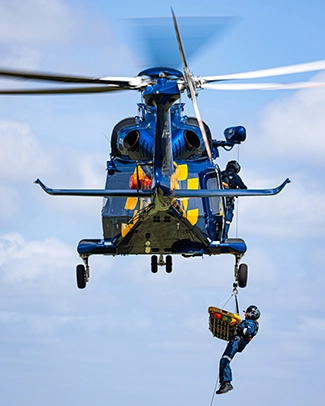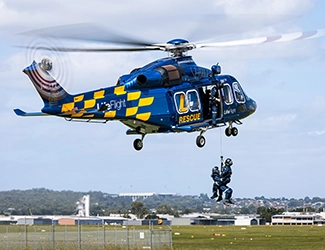PRESS RELEASE
 LifeFlight has recruited 28 critical care doctors and equipped them with specialist training to operate in a rescue helicopter environment.
LifeFlight has recruited 28 critical care doctors and equipped them with specialist training to operate in a rescue helicopter environment.
The new recruits were tipped upside down in a simulated underwater helicopter crash, had their knowledge tested in realistic clinical scenarios at Whyte Island and were winched into the sky to prepare for their new careers.
The doctors have come from far and wide to join LifeFlight’s world-renowned medical retrieval service, and all of them have a passion for providing the highest standard of critical care.
More than 180 medical professionals, including doctors, are employed by LifeFlight, making it Australia’s largest employer of aeromedical doctors.
Dr Faraaz de Belder is one of three highly-skilled doctors to join the aeromedical team based at the Sunshine Coast.
Originally from the UK, it’s his second stint with the organisation and he said a big reason he moved to Australia in 2019 was to work for LifeFlight.
“I heard about LifeFlight from watching one of the patient reunion videos on YouTube, which was a fantastic insight into what doctors do,” he said.
“I came back to LifeFlight for a number of reasons, but it’s the best job I’ve ever worked at in my 13 years as a doctor.”
Dr de Belder said one of his first rescues at LifeFlight involved an unusual farming incident.
“It was a regional farmer who was herding cattle and in the process of herding a cow and her calf, the cow unfortunately charged at him and sat on his head,” he said.
 “This man had a significant head injury. The LifeFlight team and our (QAS) ambulance service paramedic were able to deliver an emergency anaesthetic to him at the scene.
“This man had a significant head injury. The LifeFlight team and our (QAS) ambulance service paramedic were able to deliver an emergency anaesthetic to him at the scene.
“I was really fortunate to meet this man a few months later at an event LifeFlight was running and I was so pleased to see him and his wife and the fact he had made a full and complete recovery.”
For Doctor Meghan Beere, getting out of the hospital and into the back of a helicopter to provide emergency care is a dream come true.
The new retrieval registrar is one of nine new doctors to join the Brisbane LifeFlight crew and to provide critical care to Queenslanders.
“I’ve wanted to get into medicine since I was little and that passion just grew as I got older,” she said.
“Working for LifeFlight is a career dream come true for me. It represents the pinnacle of pre-hospital medicine and LifeFlight has an amazing reputation for delivering the absolute highest quality of care.”
Doctor Beere’s career history is vast, spanning across rural and remote areas such as Mount Isa and Atherton, before she settled in Brisbane.
She’s looking forward to the challenges of critical care outside a hospital setting.
“In an emergency department it is chaotic a lot of the time and it’s noisy and overcrowded,” Dr Beere said.
“Taking that sort of medicine and the critical care we provide to the back of a helicopter or on to the road, or into the back of a fixed wing, I expect it to be challenging but it will also be really exciting.”
Before heading out to help people in remote and rural areas, they underwent a week of intensive aeromedical training at the LifeFlight Training Academy.
The specialised Helicopter Underwater Escape Training (HUET), sea survival, rescue winching and clinical scenario training, will enable the new doctors to tackle whatever challenges they may face in the field.
LifeFlight HUET manager Mick Dowling, said the doctors are trained in scenarios to teach them the primary escape points of an aircraft rapidly filling with water, including simulated darkness.
“It’s important the doctors complete this training to develop escape skills that can then be transferred into an operating aircraft they are working on,” he said.
“It is highly unlikely the aircraft will be in a ditching incident, but aviation best practice requires aviators who are flying over water to complete the HUET training.”
 After the doctors were thoroughly dunked, spun, lifted from the water and taught how to survive at sea should a helicopter ditch into the ocean, they headed to the LifeFlight Clive Berghofer Maintenance Centre for winch training.
After the doctors were thoroughly dunked, spun, lifted from the water and taught how to survive at sea should a helicopter ditch into the ocean, they headed to the LifeFlight Clive Berghofer Maintenance Centre for winch training.
LifeFlight training and checking aircrew officer Todd Seymour, said winch training is a crucial part of the job that prepares the new doctors for the unpredictability of the role.
“No two days are the same here for us at LifeFlight,” he said.
“The doctors learn emergency checks around the aircraft, winch statics in the hangar and then we go out and put those statics into practice on the field.
“The doctors learn multiple exercises. They learn how to be winched out of the aircraft by themselves, how to be winched out of the aircraft with a rescue crewman or paramedic and learn how to accompany a stretcher into the aircraft.
“They’re going to remote areas across Queensland and they could be in dense bushland or out to sea off a cruise ship, so it’s important they’re delivered the training they need to perform these roles to a high and safe standard.”
The doctors had their clinical skills pushed to the limit at the Queensland Combined Emergency Services Academy, with realistic simulated scenarios in a ship, ambulance, multi-vehicle collision and house party setting.
The new recruits were also taught how to extract a patient from a road accident by Queensland Fire Department (QFD) personnel.
LifeFlight came to the aid of 8,477 Queenslanders in 2024 -13 per cent higher than the previous year.
The majority of LifeFlight critical care doctors’ work is performed on behalf of Queensland Health, tasked by Retrieval Services Queensland, within Queensland Ambulance Service.